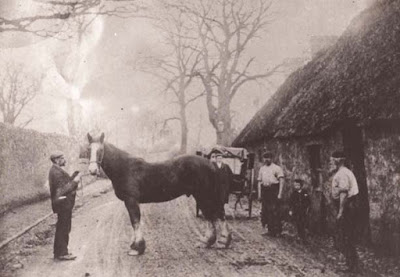EARLSTON KIRK SESSION RECORDS provide us with a unique social commentary
on life in the village at the time - with the emphasis on chastisement and charity, as the church provided help to the poor and needy, but censure to those involved in what was regarded as moral turpitude.
The Kirk Session, made up of the Minister and the Elders of the parish, was the local court of the Church of Scotland, set up after the Reformation of 1560 and the break with the Catholic Church of Rome. Its duties were to maintain good order amongst its congregation, administer discipline and supervise the moral and religious condition of the parish.
The Minute Books recorded:
Detailed accounts of income and expenditure.
Appointments of church officials,
Reports on the parish relating to poor relief, and the parish school.
Proclamations of banns, communion rolls, seat rent books and the hire of the mortcloths which was used to cover the coffin prior to burial.
Below are some random entries from Earlston Kirk Session Records 1820-1901:
- 1st January 1843 - the Kirk Session agreed that:
"The Sacrament of the Lord's Supper be dispensed on the second Sunday in February and that the Thursday preceding shall be observed a day of humiliation but likewise as a day of thanksgiving for the late abundant harvest". - 17th January 1843 - "Paid three pounds, thirteen shillings and sixpence to William Scott, Saddler, for harness, and one pound, four shillings and seven pence for laying the gas pipe from the street to the church."
- 8th January 1861 - the Session recorded the early history of the Parish School noting that it had opened the beginning of winter 1825.
- 24th November 1856 - "Mr Daniel Aitkenhead , who was lately chosen to be schoolmaster of the parish, the Session unanimously appointed to the office of Session Clerk. At the same time they appointed Mr Robert Smith to the office of Treasurer and Mr Adam Shortreed to be precentor."
- Mr Aitkenhead's signature appears at the end of many of the minutes. He went on to serve Earlston in varied roles, dying in 1922 aged 90. A memorial in the churchyard, erected by his pupils and friends noted that he was "a scholar for whom the ancient classics were his delight, a teacher of rare merit and a man to all the country dear".
- 1st May 1864 - reflecting concern for the poor, the young and the aged, 2/- was paid to a destitute family, 6/6 to a family for school fees, and 5/0 to Widow Watson.
- Bags of coal were regularly distributed to the poor, many of whom were listed as widows. The local press reported on this gift to around 50 poor of the parish who each received about 10-15cwt of fuel, supplied by William Gray, coal agent at Earlston Station. It was noted that this Kirk bounty would be very welcome in the severe winter. Below a list of recipients in 1901.
- November 1862 saw a surprising entry which reflected the church's concern for a wider mission beyond the village, with the decision that:
A collection be made in the church on Sunday, the 23rd instant in aid of the distressed cotton weavers in Lancashire.
This was at the time of the American Civil War when a blockade of ports in the Southern states meant that raw cotton supplies were not reaching Lancashire and workers at the mills were unemployed and facing hardship.
- 4th December 1859 - the Kirk Session discussed a £200 legacy from William Rutherford, spirit merchant of Bruntsfield Place, Edinburgh to be used "for the benefit of the poor". £200 in 1859 is equivalent to about £19.000 today, so a huge sum. According to a newspaper report on the bequest, Mr Rutherford was believed to be native of Earlston.
- Two pages of accounts for 1864 note payments to Robert Shillinglaw (a church official}, the salary to the precentor increased to £10 per annum, for communion wine, and the cleaning of the church yard walls, - and a rather unusual entry for the supply of cod liver oil.
- Income came from legacies, church collections, fees for proclamation of the banns, from fines, and from the hiring of the hearse and mortcloth for burials. It was customary for Kirk Sessions to hire out a mortcloth (funeral pall) to cover the coffin or corpse during the funeral service. From the point of view of family historians, the Earlston records unfortunately do not name the deceased person.
- Many entries abound with the church's concern for what was termed "ante-nuptial fornication". The notable feature of these record is the fact it is the woman who bears the brunt of the "rebuked".
- 7th May 1820 - it was confession time for Isabel Dunn - although she had had a child out of wedlock, she now wished to have her church privileges restored. Compassion was duly shown.
- As late as 14th October 1901, a woman was brought before the Kirk Session to be questioned on her "sin of fornication and having a child out of wedlock".
"Having confessed in sorrow for her sins and resolution to walk through grace in newness of life, the Moderator after solemn admonition did in the name of the Kirk Session absolve her from the scandal of her sin and restore her to the privileges of the church,"
How attitudes have changed!
Note: Parochial boards later took over responsibility for matters such as poor relief, with elected parish councils introduced in 1894.
***************
Scottish Kirk Session Records are not available online, but many archive centres across the country have them available in a digitised format for their area, including the Heritage Hub, at Hawick, which serves the whole of the Scottish Borders.






















